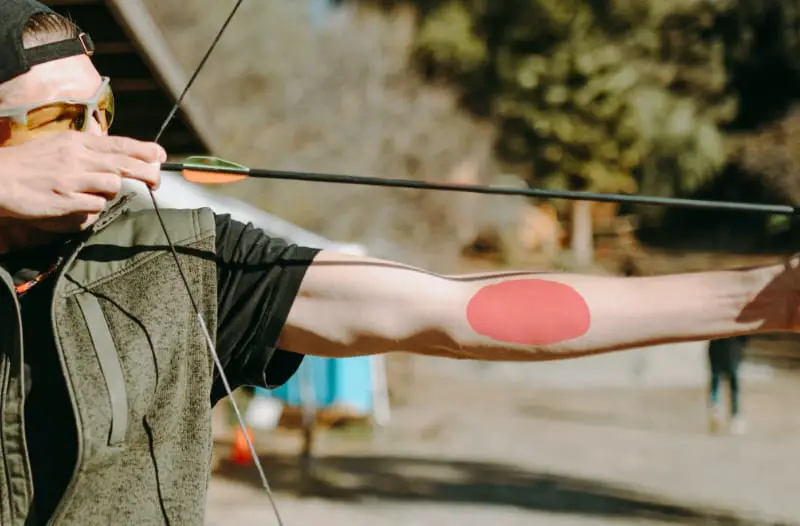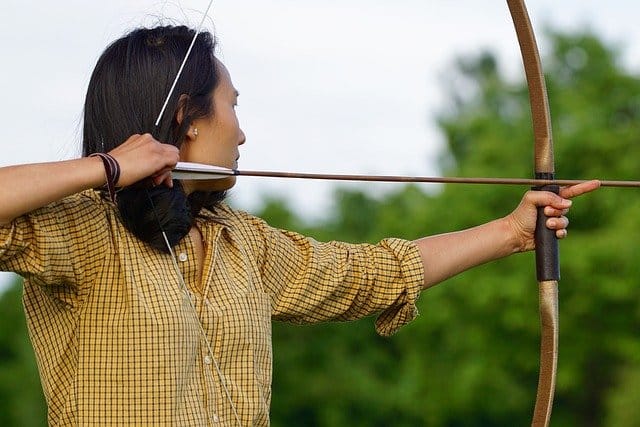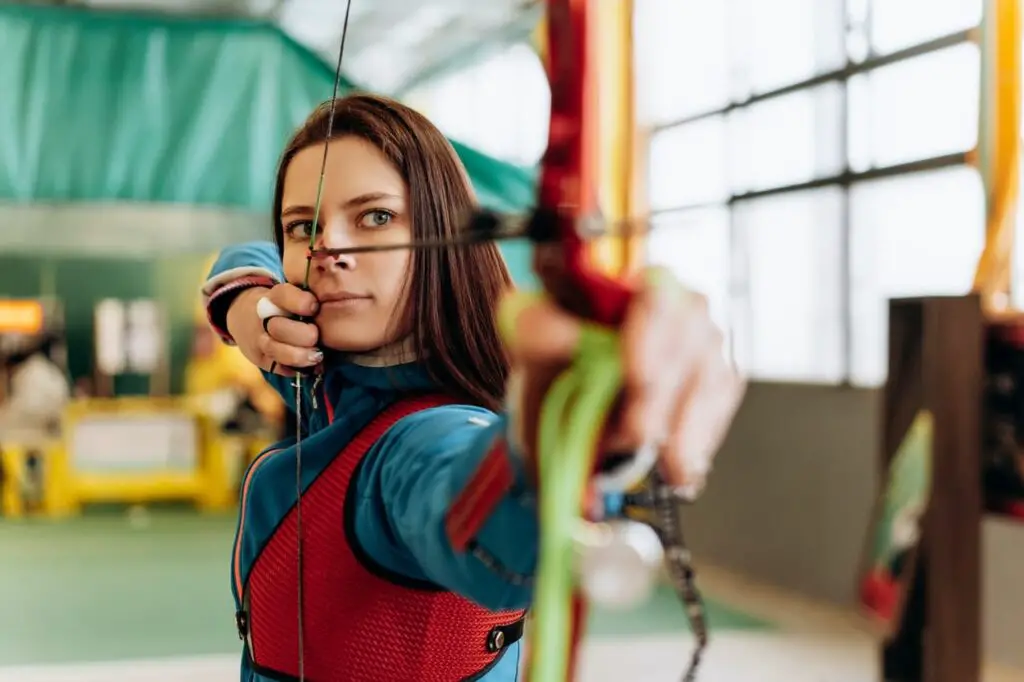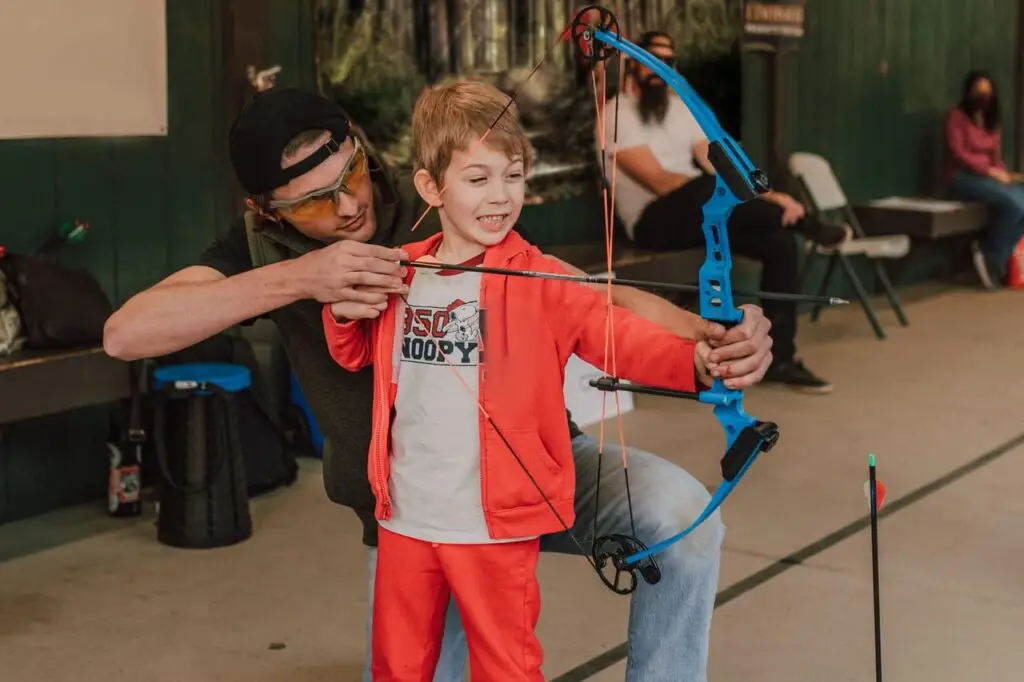Archery can be a lot of fun, but it can also wreak havoc on your arms if you are not careful. Bow slap is a common concern, so you might be wondering how you can prevent that from happening to you moving forward. Thankfully, there are some things that you can do to minimize the possibility of a bow slap.
Just about everyone who has ever done archery has experienced bow slap. It impacts beginner and advanced archers alike. If you are looking for ways to prevent this, you have come to the right place. Continue reading to discover some helpful tips that should enable you to prevent bow slaps in archery moving forward.

What is a bow slap?
Bow slap happens when the string from an archery bow slaps the archer’s forearm as they shoot an arrow. While it typically affects beginning archers, even advanced ones can suffer from bow slap if they are not careful. It can leave quite a bruise on the forearm of the archer.
If you or someone you know is frequently getting bow slapped, then it likely has to do with technique. You can implement some strategies right away that will help minimize the possibility of bow slapping becoming an issue for you. This is important because bow slap can really hurt your arm if allowed to go unchecked.
10 ways to prevent a bow slap
If you frequently encounter bow slaps in archery, it is time to reconsider your strategy. Beginners and advanced archers alike need to take a look at their technique when shooting arrows from time to time. As you do, consider the following ten ways to prevent bow slap as a way to help protect your arm and keep it from possible injury.
Read about how you can treat bow slap bruises.
1. Use an armguard
If you have never used an armguard, it is probably time that you practiced using one. This is not just something for beginners. Many advanced archers consider an armguard to be an essential part of the equipment that they use in the sport. It is a way of protecting your forearm against a potential bow slap.
You might be asking why you need an armguard at all if you are employing these other techniques that we are talking about in this post. The reality is that bow slap can impact even advanced archers from time to time. There is really nothing you can do to eliminate the risk of bow slap altogether, so this is a way of protecting yourself against the eventuality.
An armguard is designed to take the brunt of the impact from a bow slap. When your armguard is used, you will be so thankful that you were wearing it. You never know when your technique is going to falter and the string makes contact with your forearm. This is why you will want to consider using an armguard every time you set out to engage in archery.
2. Loosen up your grip
Bow slap often occurs because the archer is gripping the bow way too tightly. This involves holding the bow incorrectly, so that needs to be corrected. To begin, you will want to make sure that you are not holding your bow up. Remember that your bow hand is only to be used for support, so you will not want to overthink the grip at this point.
If you are a person who tends to grip down on the bow too tightly with the hand that is holding the bow, then you will find that the bow actually rotates once it is released. This ends up bringing the string much closer to your forearm than it is designed to be. If you are not careful, a bow slap will be the inevitable result.
In order to correct this, you will want to make sure that you are shooting your arrows with an open grip on the bow. This will have the effect of reducing the torque on your equipment, thereby allowing the bow to rotate away from the arm holding the blow. This will significantly decrease the odds that the string will end up slapping against your forearm.
3. Make sure you’re using the right part of your hand
Hand placement is critical in archery. Not only does your hand dictate the direction and force with which your arrow is shot, it is has a great deal to do with your overall comfort while participating in the sport. As such, it is important that you use your hand correctly, as this will impact the way the string responds once the bow is released.
When you go to hold your bow, you need to ensure that grip is such that it sits right up against the padding of your thumb. It is best to practice this many times before you start to shoot just so you can get the hang of it. If you set the bow too deeply into the palm of your hand, the resulting torque can rotate the string on the bow right towards your forearm as it is released.
3. Shorten up your draw length
If you frequently encounter bow slap, you may also want to take a look at the draw length of the bow. This is critical in determining how the string reacts when you go to release the arrow. If you end up setting the bow length too long, then you will discover that your arm holding the bow ends up being too close to the string for comfort.
When your draw length is too long, there is a good chance that the string will wind up hitting your forearm. You can fix this by visiting the archery shop that you buy your equipment at. Ask an expert there to ensure that your draw length is set at just the right length, given your body and arm length.
4. Make sure you use the proper stance
Many people do not realize just how vital your stance is when it comes to shooting archery. If you have the wrong stance, this will significantly impact how the bow reacts when released. In order to get the best result, most expert archers will tell you to shoot your bow and arrow while you are in an open stance. This will give you the best leverage and provide you with protection as well.
In order to get the stance just right, you will want to make sure that you bring your lead foot back and out to the point that you can then open up your entire body just a bit more. This will then permit your arm holding the bow to be further away from the bowstring’s path as the arrow is released.
You should also read about why archers wear shoulder pads.
5. Rotate your elbow to the proper position
Another thing that you might not be aware of is how important your elbow position is as you engage in archery. Your elbow will determine the amount of torque that comes off the bowstring. It will also determine how close your forearm is to the string once you release the arrow. Working on your elbow positioning will help minimize possible bow slap.
Your elbow will need to be rotated as you shoot. The key is to practice how to do this properly. Being in the correct position means that your arm is extended out. At the same time, you will want to rotate your elbow out while ensuring that you have not rotated either your shoulder or your wrist.
This will take some practice, but eventually, you will learn to shoot your arrow without incorrectly rotating your elbow. One way to practice is to ditch the bow and arrow altogether. Instead, put your palm flat up against the wall. Once you have done that, rotate your elbow while making sure that the palm of your hand or your shoulder never moves.
7. Advanced archers need to constantly analyze their technique
Just like most sports, you will eventually get in a rut with your routine. Things that you used to practice and focus on with your technique might quickly be forgotten. This is when mistakes start to happen. For example, you might go many months without ever coming close to experiencing bow slap only to discover that you are now getting hit with the string with about every shot.
This is why even advanced archers need to take time out to analyze everything about their technique once in a while. If bow slap is starting to creep in, then it is time to figure out why. Go back to the basics and make sure that you are doing everything that you can do to minimize the risk that your forearm will end up being too close to the string.
With all of the modern technology available today, the process of analyzing your technique is made easier than ever before. You can consider having someone videotape you shooting during a practice session. Take a look at the video and determine what you should be doing better in order to prevent bow slap moving forward.
8. Refrain from bending backwards
In archery, posture is crucial. Earlier, we talked about how your stance can impact the potential of a bow slap. Now it is time to think about how straight you are actually standing while you shoot the arrow. In essence, it is important that you do everything you can to get from bending backward as doing so will bring your forearm too close to the string.
Beginners often start out in archery being taught to use a square stance. While this is useful to get your feet wet in the sport, you eventually want to move to an even wider stance where your feet are spread more apart. This will give you more control over the bow. As you pull the string, keep your back straight and resist the temptation to sway backward.
9. Make sure you’re not fatigued
Just like with many things in life, it is important to be refreshed and energized when you are ready to do archery. The bow is heavy and the string has a lot of resistance built into it. In order to do all of this correctly, there is a lot of focus and resolve that is necessary. If you are overly fatigued, you will find that your technique suffers, and the bow slap will begin to creep in.
Fatigue impacts archers in many different ways. To begin, it will wreck the good posture that we just talked about. When you are tired, it is challenging to keep your back straight. It is human nature to begin to relax. When you are about to shoot an arrow, you need to be sure that you have the energy to keep all of your body parts in the proper position. Working out and strengthening your back arms does help you hold a proper posture steady. It’s very well known for archers to do water slapping.
When you are energized and feeling good, you will be able to use your muscles to hold onto the bow properly. This will keep the bowstring in place and make it far less likely to come into contact with your forearm as you shoot. It would help if you remembered to lock in your muscles and pull the string at the right moment in order to be successful.
Does archery actually require a lot of strength?
10. Use a lighter bow if necessary
If you have analyzed your technique, found that you are doing all of the right things, and still are encountering a bow slap situation, you might want to consider using a lighter bow. If your bow is too heavy, it is going to be difficult to hold in the proper position for a long time. This can be especially problematic if you are hunting.
If this is the situation you are encountering, you either need to build upper body muscle strength or buy a lighter bow. You do not want to keep having the string hit your arm simply because the bow is too heavy for you.
Final thoughts
Bow slap can take the enjoyment out of archery, but thankfully there are ways to prevent it. Following the tips provided in this post will go a long way towards helping you do exactly that. Your arm will certainly thank you as the bow stops making contact every time you shoot an arrow.


